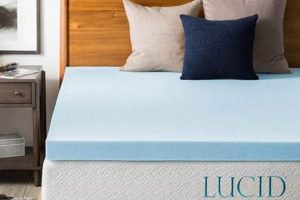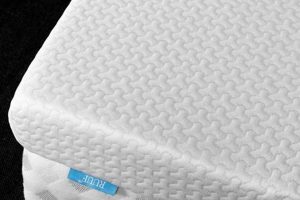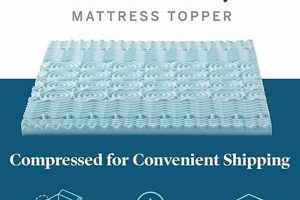The core subject of discussion revolves around two common mattress sizes primarily intended for single sleepers. One configuration measures approximately 39 inches wide and 75 inches long. The alternative offers the same width but extends its length to around 80 inches. This dimensional difference significantly impacts suitability for different body types and room configurations.
Understanding the variation between these sizes is important for maximizing comfort and optimizing space utilization. The shorter option has been a standard for children’s rooms and smaller spaces for many years. The extended version provides additional legroom and often serves as a suitable choice for taller individuals or those preferring a more spacious sleeping surface, particularly in dormitories or guest rooms.
The following sections will delve into the specific considerations of each size, examining ideal user profiles, typical applications, and potential drawbacks to aid in informed decision-making regarding which best suits individual needs and spatial constraints. We will further compare the common uses, best suitability, and price point comparison.
Selecting Between Mattress Sizes
This section outlines essential considerations when evaluating the dimensional differences in single-sleeper mattresses, assisting in an informed decision based on individual needs and circumstances.
Tip 1: Assess Occupant Height: For individuals exceeding six feet in height, the extended length is often preferable. A shorter mattress may result in discomfort due to constrained legroom.
Tip 2: Evaluate Room Dimensions: Measure the available space before making a purchase. The longer mattress requires more floor area, which may impact room functionality.
Tip 3: Consider Intended Use: Determine the primary purpose of the mattress. Dorm rooms and guest accommodations often benefit from the added length, while children’s rooms may not require it.
Tip 4: Examine Bedding Availability: Ensure that appropriately sized sheets and blankets are readily accessible. Standard bedding may not fit an extended-length mattress properly.
Tip 5: Analyze Budget Constraints: The extended length options can sometimes command a slightly higher price. Factor this into the overall cost consideration.
Tip 6: Account for Future Needs: Consider potential future uses for the mattress. Selecting the longer option may provide greater versatility over time.
Tip 7: Evaluate Frame Compatibility: Verify that the existing or planned bed frame is compatible with the chosen mattress dimensions. Incompatible frames can compromise support and longevity.
Careful consideration of these factors enables a more informed selection, optimizing comfort, space utilization, and long-term value.
The subsequent section will provide a direct comparison of common uses, suitability, and price points between these options.
1. Occupant Height
Occupant height is a primary determinant in selecting an appropriate mattress size from these two options. The selection process requires a critical assessment of the sleeper’s physical dimensions to ensure adequate support and comfort. Failure to account for height can lead to compromised sleep quality and potential physical discomfort.
- Legroom Restriction and Spinal Alignment
Insufficient mattress length can force the sleeper to curl up or bend their legs, disrupting spinal alignment. This misalignment can cause back pain, stiffness, and reduced sleep quality. For individuals taller than average, the extended length becomes crucial for maintaining a neutral spine during sleep. Examples include taller teenagers outgrowing standard sizes and experiencing discomfort from constrained legroom.
- Edge-to-Edge Support
When a sleeper’s feet hang off the end of the mattress, they receive no support. This lack of support can lead to circulatory issues, numbness, or tingling in the legs and feet. The extended length ensures the entire body receives adequate support from head to toe, promoting healthy blood flow and reducing pressure points. An example of this would be taller athletes who need full body support.
- Overall Comfort and Restful Sleep
A mattress that is too short inhibits the sleeper’s ability to fully stretch out and relax. This restriction can lead to restlessness, frequent awakenings, and a feeling of being confined. The longer mattress enables more freedom of movement and a greater sense of spaciousness, contributing to deeper, more restful sleep. Individuals who frequently change positions during the night may find additional comfort.
- Long-Term Postural Health
Consistently sleeping on a mattress that does not accommodate the sleeper’s height can lead to long-term postural problems. The body may adapt to the restricted space by adopting unnatural sleeping positions, which can strain muscles and joints over time. Selecting the appropriate size promotes healthy posture and minimizes the risk of musculoskeletal issues in the long run. A person with pre-existing back problems will benefit greatly from this increased postural health.
The correlation between occupant height and mattress selection directly impacts sleep quality and physical well-being. The extended length provides significant advantages for taller individuals, mitigating discomfort, promoting spinal alignment, and ultimately contributing to more restful and restorative sleep. Prioritizing occupant height during the mattress selection process is essential for optimizing both short-term comfort and long-term health.
2. Room Dimensions
Room dimensions directly influence the suitability of mattress sizes. The longer mattress configuration requires more floor space than its standard counterpart. Failure to adequately assess available area before purchase can result in spatial inefficiencies and compromised room functionality. The relationship can be understood through cause and effect; smaller rooms may only accommodate the shorter version, while larger rooms offer greater flexibility. For example, a compact studio apartment may only allow for the standard size, while a larger bedroom in a family home might easily house the extended version.
The practical significance of this understanding extends to interior design and furniture arrangement. Selecting a mattress size disproportionate to the room can hinder movement, limit storage options, and create an unbalanced aesthetic. In shared living spaces, such as dormitories, optimizing room space is critical. Choosing the most appropriate mattress size helps maximize usable area for studying, socializing, and storing personal belongings. Furthermore, in smaller guest rooms, opting for the standard size can free up space for additional furniture, such as a desk or seating area, enhancing the guest experience.
In summary, room dimensions serve as a constraint or enabler when selecting between mattresses. Careful measurement and spatial planning are essential to ensure the chosen size integrates seamlessly into the room layout. This thoughtful approach optimizes functionality, improves aesthetics, and enhances the overall living environment. Ignoring the correlation between spatial constraints and mattress dimensions can lead to practical difficulties and diminish the room’s intended purpose.
3. Intended Use
The intended application significantly influences the selection between these two mattress sizes. Factors such as user demographics, room function, and frequency of use dictate which dimension offers greater practical value. Considering these factors allows for a targeted, needs-based selection process.
- Dormitory Accommodation
In dormitory settings, extended-length options are frequently preferred due to the prevalence of taller students. Limited space necessitates efficient utilization, and providing adequate sleeping arrangements for the majority of occupants enhances overall living conditions. Standard mattresses may prove inadequate for a significant portion of the student population.
- Children’s Bedrooms
Standard mattresses are often suitable for children’s rooms. The shorter length accommodates smaller body sizes and leaves more floor space for play and other activities. Extended length may be unnecessary and consume valuable room area that could be better allocated.
- Guest Rooms
Guest rooms present a varied scenario. If the guest room caters primarily to adults, the extended length is generally a more versatile option, accommodating a broader range of heights. If the guest room is intended for children, the standard size may suffice. Anticipating the typical guest profile informs the ideal mattress selection.
- Short-Term Rentals
For properties such as vacation rentals or short-term apartments, catering to a diverse clientele is essential. Extended length is often the more prudent choice, providing a comfortable sleeping surface for most individuals. While the standard version might suffice, the extended length minimizes potential complaints and enhances guest satisfaction.
The interplay between intended use and mattress dimensions underscores the importance of assessing specific needs and user profiles. A nuanced understanding of these factors guides the selection process, ensuring optimal comfort and spatial efficiency. Neglecting to consider the intended application can lead to suboptimal choices, compromising user satisfaction and room functionality.
4. Bedding Fit
Bedding fit is directly contingent upon mattress dimensions. These two mattress sizes present distinct bedding requirements, impacting both comfort and aesthetic presentation. Standard bedding designed for the shorter configuration will prove insufficient for the longer version, resulting in inadequate coverage and potential detachment during sleep. The relationship is one of dimensional compatibility: a properly sized sheet set is essential for a snug, functional fit. An example would be attempting to use a standard sheet on an extended-length mattress, exposing the mattress corner and compromising comfort. Understanding this dependency is important to avoid unnecessary cost and frustration.
The practical implications of mismatched bedding extend beyond mere aesthetics. Ill-fitting sheets can bunch up, creating discomfort and disrupting sleep. They may also fail to adequately protect the mattress from spills and stains. Conversely, oversized bedding on the shorter configuration can create excess fabric, posing a tripping hazard and detracting from the overall appearance of the bed. A correctly sized fitted sheet will stay secure during use, and is important for hygiene reasons. Securing appropriately sized sheets and blankets ensures optimal comfort, extends the lifespan of bedding and mattresses, and contributes to a visually pleasing and functional sleep environment. Furthermore, it avoids unnecessary wear and tear on the bedding itself.
In summary, bedding fit is an essential consideration when selecting between the two mattresses. Investing in appropriately sized sheets, blankets, and comforters optimizes comfort, enhances the aesthetic appeal of the bed, and protects the mattress. Overlooking this connection can lead to discomfort, inconvenience, and unnecessary expenditure. Bedding fit is the logical companion of size when determining what will work best for individual needs.
5. Budget Factors
The financial aspect represents a significant consideration in the decision-making process when selecting between standard and extended-length mattresses. Cost implications extend beyond the initial purchase price and encompass associated expenses, such as bedding and potential frame modifications. Careful assessment of budgetary constraints is necessary to ensure a financially sound decision.
- Initial Purchase Price
Generally, extended-length mattresses command a slightly higher initial purchase price compared to their standard counterparts. This price differential reflects the increased material and manufacturing costs associated with the larger dimensions. Consumers operating under strict budgetary limitations should carefully compare prices across various retailers and consider promotional offers to mitigate this expense. Discounts may also be available during seasonal sales events.
- Bedding Costs
As detailed previously, specialized bedding is required for extended-length mattresses. Standard sheets, blankets, and comforters will not adequately fit, necessitating the purchase of appropriately sized replacements. These specialized bedding items can incur additional costs, further impacting the overall budget. Factoring these supplementary expenses into the decision-making process is crucial for avoiding unforeseen financial burdens.
- Frame Compatibility and Modification
Existing bed frames designed for standard mattresses may not be compatible with extended-length versions. In such cases, frame modifications or complete replacements may be necessary. These modifications or replacements represent additional expenses that must be considered during the budgeting phase. Verifying frame compatibility prior to purchase mitigates the risk of incurring these supplementary costs.
- Long-Term Value and Durability
While the initial costs associated with extended-length mattresses may be higher, their potential for increased long-term value should be assessed. The suitability of the extended length for a wider range of users may prolong its usability, reducing the need for premature replacement. Evaluating durability and considering the potential for longer lifespan informs a more comprehensive assessment of the overall cost-effectiveness.
In summary, budgetary considerations play a pivotal role in the selection. While extended-length versions offer advantages in terms of comfort and accommodation, the higher initial purchase price, associated bedding costs, and potential frame modifications must be carefully weighed against the benefits of increased size and long-term value. A thorough budgetary analysis ensures that the final decision aligns with financial constraints while optimizing sleep quality and overall satisfaction.
6. Frame Compatibility
Frame compatibility represents a critical, often overlooked, aspect of mattress selection, especially when differentiating between standard and extended-length mattresses. The consequences of neglecting to verify compatibility can range from compromised mattress support and accelerated wear to outright inability to use the chosen mattress. The relationship between frame dimensions and mattress dimensions is one of physical constraint: a frame too small will not accommodate the larger mattress, and a frame too large will not provide adequate support.
The importance of frame compatibility extends to ensuring proper weight distribution and preventing premature mattress sagging. A mismatched frame can concentrate pressure on certain areas of the mattress, leading to uneven wear and reduced lifespan. For instance, an extended-length mattress placed on a standard-length frame will likely overhang at one end, creating a point of weakness and potentially damaging the mattress structure. Likewise, a frame designed for a standard-length mattress may not offer sufficient support for the extended version, particularly if the mattress is densely constructed. The situation can be further complicated when using platform beds or adjustable bases. Platform beds with built-in dimensions must precisely match the mattress size to provide adequate support across the entire surface. Adjustable bases, which allow for customized positioning, also require specific dimensional compatibility to ensure proper functionality and prevent damage to the mattress or the base itself. Neglecting to verify that the mattress and frame are compatible could result in voided warranties from both the mattress and frame manufacturers.
In summary, frame compatibility is not merely an aesthetic concern but a functional imperative. Precise alignment between mattress dimensions and frame dimensions is essential for ensuring adequate support, preventing premature wear, and maximizing the lifespan of both the mattress and the frame. Overlooking this aspect can lead to financial losses and compromised sleep quality. The practical advice for optimal decision-making is precise measurements and verifying manufacturer specifications. This ensures long-term satisfaction with the bedding system.
Frequently Asked Questions
This section addresses common inquiries concerning dimensional disparities in single-sleeper mattresses, providing concise and informative responses.
Question 1: What is the primary dimensional difference?
The principal distinction lies in the length. While both share a width of approximately 39 inches, the extended-length mattress measures around 80 inches in length, compared to the standard length of approximately 75 inches.
Question 2: Who is the extended-length version best suited for?
It is primarily intended for taller individuals, typically those exceeding six feet in height. The additional length provides adequate legroom and prevents discomfort caused by constrained space.
Question 3: Does standard bedding fit the extended-length version?
No. Standard-sized sheets, blankets, and comforters will generally not provide adequate coverage for the extended-length mattress. Appropriately sized bedding is required.
Question 4: Is it more expensive?
Generally, the extended-length option commands a slightly higher initial purchase price compared to the standard size, owing to increased material and manufacturing costs. However, pricing variations depend on retailer, brand, and mattress construction.
Question 5: What types of rooms are best suited for each size?
The standard size is often appropriate for children’s rooms or smaller spaces, while the extended-length is commonly found in dormitories, guest rooms, and accommodations for taller individuals.
Question 6: How does frame compatibility factor into the selection?
Existing bed frames designed for the standard size may not be compatible with the extended-length version. Frame modifications or replacements may be necessary. Verifying compatibility prior to purchase is essential.
In summary, the suitability of each size hinges on a variety of factors, including occupant height, room dimensions, bedding availability, and budgetary considerations. A thorough assessment of these variables enables informed decision-making.
The subsequent section will provide a final overview, summarizing key considerations and offering recommendations for optimizing mattress selection.
Twin Mattress Versus Twin XL
This exploration of “twin mattress versus twin xl” has underscored the critical dimensional differences between these single-sleeper mattress options. Key determinants in the selection process include occupant height, room dimensions, intended use, bedding compatibility, budgetary constraints, and bed frame specifications. Neglecting these factors can lead to suboptimal sleep quality, spatial inefficiencies, and unnecessary financial burdens. This analysis emphasized that the extended length offers distinct advantages for taller individuals and certain room configurations, while the standard length remains a viable choice for children’s rooms and more confined spaces.
Ultimately, selecting the appropriate mattress requires a thoughtful assessment of individual needs and circumstances. This information seeks to empower consumers to make informed decisions, prioritizing both comfort and long-term value. Further research is encouraged to address evolving needs and optimize sleep environments. This ensures the best match in mattress dimensions for years to come.




![Best Memory Foam Twin XL Mattress [Guide] Comfort Sleep! Organic & Natural Mattress Buyer’s Guide: Non-Toxic Sleep Solutions Best Memory Foam Twin XL Mattress [Guide] Comfort Sleep! | Organic & Natural Mattress Buyer’s Guide: Non-Toxic Sleep Solutions](https://mattressworldpa.com/wp-content/uploads/2025/07/th-875-300x200.jpg)

![Best Twin XL Pillow Top Mattress [2024 Guide] Organic & Natural Mattress Buyer’s Guide: Non-Toxic Sleep Solutions Best Twin XL Pillow Top Mattress [2024 Guide] | Organic & Natural Mattress Buyer’s Guide: Non-Toxic Sleep Solutions](https://mattressworldpa.com/wp-content/uploads/2025/07/th-873-300x200.jpg)
